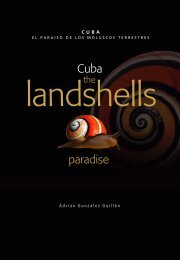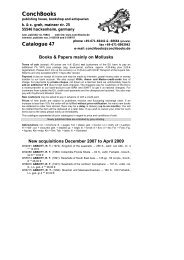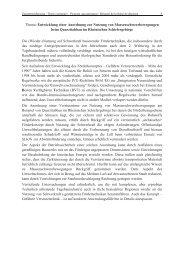Madeira Canary Islands Azores – Fishes Dr. Peter Wirtz
Madeira Canary Islands Azores – Fishes Dr. Peter Wirtz
Madeira Canary Islands Azores – Fishes Dr. Peter Wirtz
Create successful ePaper yourself
Turn your PDF publications into a flip-book with our unique Google optimized e-Paper software.
and seahorses, it is the male that carries the eggs, in a pouch or a fold on the belly. Bony rings or half-rings<br />
protect the body, instead of scales; this, however, reduces flexibility. Pipefishes and seahorses use their long<br />
snout to suck up small animals as if it were a pipette. The “gestation period” of our seahorse species is only<br />
three to five weeks (any time between April and October). The babies hatch with a length of about 15 mm.<br />
Photo <strong>Peter</strong> <strong>Wirtz</strong>.<br />
Great pipefish (Syngnathus acus)<br />
Up to 46 cm long. <strong>Madeira</strong>, <strong>Canary</strong> <strong>Islands</strong>, <strong>Azores</strong>. 3 <strong>–</strong> 30 m depth.<br />
The Great pipefish has a particularly long snout, by which it can be told apart from other pipefish species.<br />
Males reach sexual maturity with about 30 cm length and carry the eggs on the belly, protected on the left and<br />
right by a skin fold but open to view. The babies are born with a length of about 25 mm. Like most other<br />
pipefishes, the Great pipefish mainly lives in sea grass meadows, but also between other plants on rock or<br />
sand. Photo <strong>Peter</strong> <strong>Wirtz</strong>.<br />
50<br />
Scorpion fishes (Scorpaenidae)<br />
<strong>Madeira</strong>-scorpionfish (Scorpaena maderensis)<br />
Up to 15 cm long. <strong>Madeira</strong>, <strong>Canary</strong> <strong>Islands</strong>, <strong>Azores</strong>. 2 <strong>–</strong> 40 m depth.<br />
Scorpion fishes owe their name to the many poisonous spines carried on the body. It is better to not touch<br />
them! The sting hurts but is not really dangerous. The <strong>Madeira</strong>-scorpionfish is one of the most common fish<br />
species on hard bottoms from the <strong>Azores</strong> to the <strong>Canary</strong> <strong>Islands</strong>. It can be recognized by the many small black<br />
dots and the small white skin flaps on the head. The quite similar looking <strong>Canary</strong>-scorpionfish (see next page)









